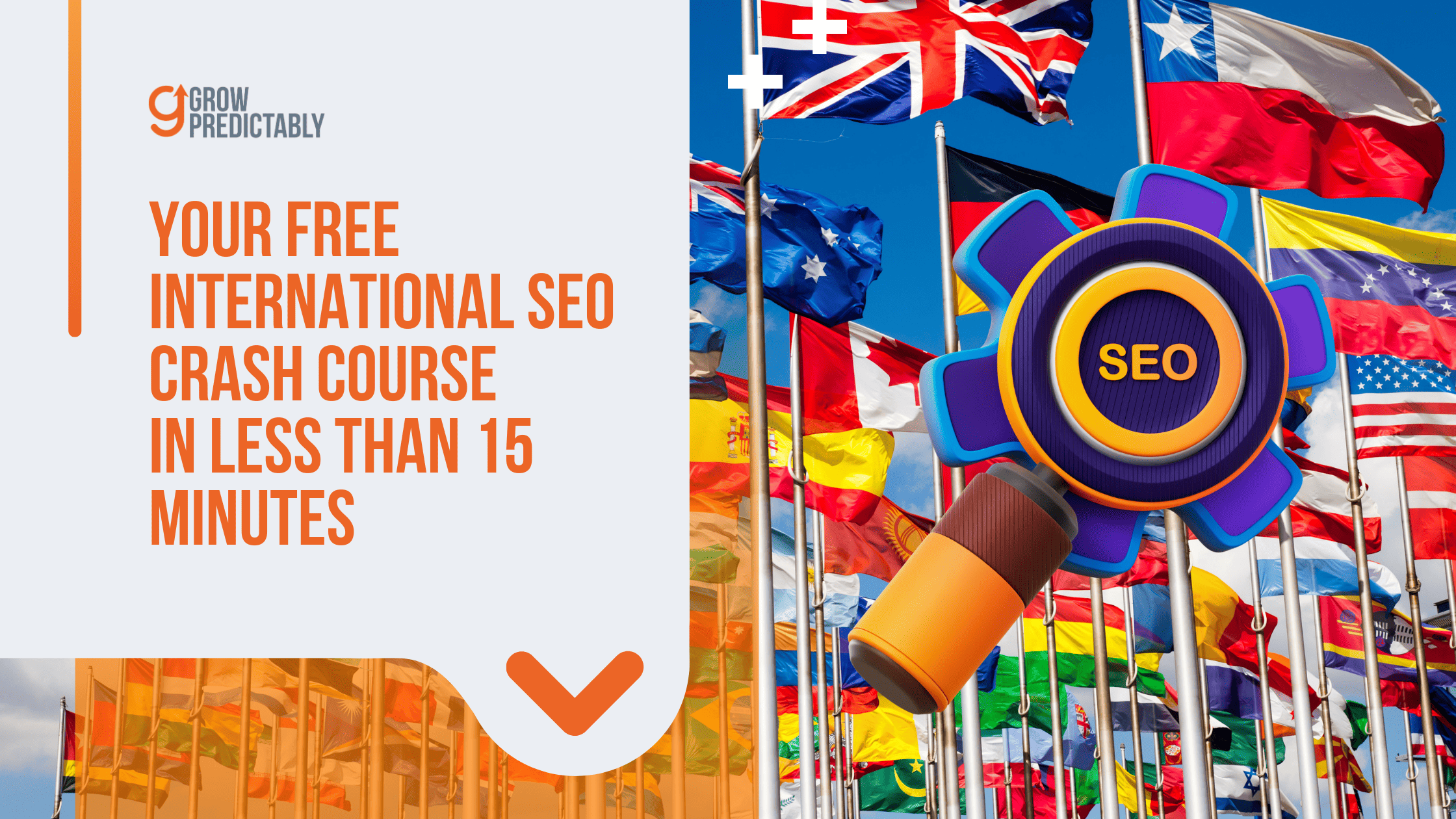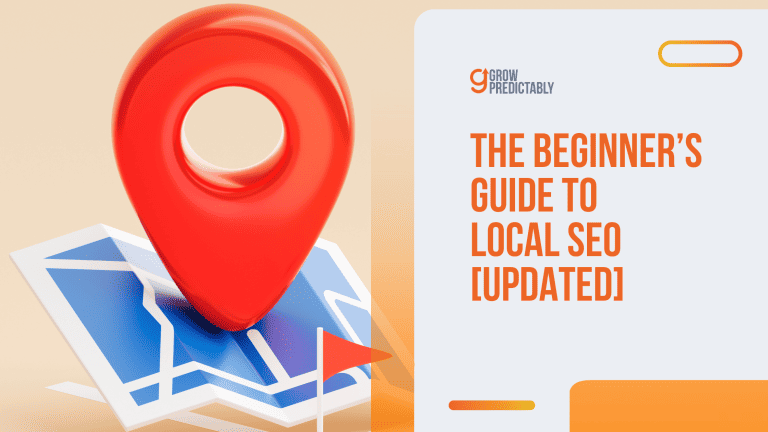Your Free International SEO Crash Course in Less Than 15 Minutes
You’ve worked hard to create a great website, but you’re not getting the traffic you want from other countries. It can be tough to break into new markets and get your website seen by foreign users.
Even if you know the language, without the proper optimization, your website is invisible to the billions of people who use search engines in territories that are outside of your own.
International SEO is the answer. By optimizing your website for international users, you make it easier for search engines in other countries to find and rank your site.
So what even is international SEO? How is it different from regular SEO? How does international SEO work? In this article, let’s take a quick crash course on international SEO and how you can best implement it in your own SEO efforts.
A Brief Overview of International SEO – What It is and Why it’s Important
International SEO is all about adapting and optimizing your website for different countries and languages—outside of your own—for the same goals that you would have with your regular SEO efforts.
It involves researching and understanding regional keyword trends and ranking factors, as well as tailoring your content to the target users in each country or region.
It also involves tailoring the technical aspects of your website in order to ensure it runs efficiently in any given country.
Ultimately, it’s about making sure that you are at your most visible to your target foreign market—something you should definitely look into if you want global attention to your brand.
Traditional SEO vs. Local SEO vs. International SEO

Here’s an example of an SEO basic: Having a comprehensive knowledge of the different types of search engine optimization (traditional, local, and international SEO).
It is essential for businesses that want a successful online presence!
In this section, we’ll dive into the nuances of each type and discuss how they differ from one another.
Traditional SEO
Traditional SEO is the process of optimizing a website so that it ranks highly in organic results in search engines. It is focused on optimizing content with relevant keywords to rank for generic searches that receive a significant volume of traffic.
Local SEO
Local SEO focuses on optimizing websites for local audiences, allowing businesses to be visible for local searches. A local SEO strategy typically involves detailed location information such as an address, zip code, city name, and phone number.
International SEO
International SEO or multilingual SEO is similar to traditional/regular SEO and involves optimizing content to be visible across different target countries or regions speaking different languages.
Additionally, international SEO requires careful consideration of cultural differences between different countries and languages when writing content and selecting keywords.
When Should You Start Worrying About International SEO?
Search engines are ubiquitous, and search has become an integral part of the online experience, so having your content optimized for search engine visibility makes sense when you’re trying to reach broader audiences beyond your current location.
The best time to implement international SEO is when you’re ready to go global. But there’s more that goes into that than just being ready. Being “ready” for international SEO also means checking off three things.
- Your current SEO performance – Before you start worrying about international SEO, determine first if you’ve successfully established a footing in your own region. If your traditional SEO ranking is decent, it’s better to focus more on your regular SEO efforts.
- Enough budget – Expanding your reach online to other international territories costs money. For some brands, it can even go to hundreds of thousands of dollars, sometimes even millions. If you’re planning to invest in international SEO, check the budget.
- The profitability of your international target market – Before you expand your online reach, first, determine if the foreign market that you’re targeting is receptive to your offer. If most people can’t afford your services, there’s no point in expanding your services in that market.
Identifying Your Target—International Markets
For businesses looking to expand their reach internationally, identifying the target country or foreign language that you want to serve is the first step to any international SEO campaign.
This comes before you identify the keywords with the most ideal search volume or invest any effort in content marketing. Especially because you’re going to try and speak the same language as your target.
While it’s true that international search engine optimization can help spread awareness about your products and services, you first need to identify which countries are best tailored to your business model and goals.
This means extensive market research on different languages, cultural preferences, economic and technological trends, assessing the local competition, and the size of each foreign market.
From there, businesses can create international marketing plans to ensure they optimally target the local audience of the global market that they wish to reach.
The Critical Factors That Affect International SEO

International SEO is a complex task, with success weighted down by many different elements.
However, if you know what factors are critically important in wrapping up an effective international SEO strategy, the entire process becomes much simpler and more straightforward.
Let’s take a look at some of them here.
Google is different in English and in other languages
Google’s natural language processing capabilities are far more advanced in English than in any other language, which makes international SEO strategies all the more challenging.
International SEO involves much more than simply translating English content – it requires understanding the different cultural tones and behaviors of international audiences.
Never use auto-translation. This can cause mistranslations that will affect how Google and readers comprehend your content, which can also affect your ranking.
This, just as well, includes staying up to date with local trends that affect international search results.
Country targeting or language targeting?
When it comes to international SEO strategies, the difference between a language-focused and a country-focused strategy is crucial. This is because your strategies may need to change depending on what type of targeting you implement.
Using a target language—let’s say in Spanish—allows your international SEO campaign to target a bigger audience due to the vast Spanish-speaking population scattered worldwide.
But, even if your targets speak the Spanish language, if they’re split between living in Mexico and Argentina, there are still going to be cultural differences despite them speaking the same language.
However, if you want to target an international market deeper, a country-focused strategy will allow you more control if you know your target country in terms of culture, customer behavior, colloquial language, and other country-unique factors.
Language targeting is considered a broader approach. Targeting a specific country, on the other hand, is more focused. But because it considers more factors, it’s also more complex.
Google’s geographic target setting
When it comes to international SEO strategies, don’t forget to check the Google Webmaster Tool for accuracy.
This can be a surprisingly easy way to check whether the region you’re targeting with your international SEO is correctly associated with your website.
So why not take a moment now to double-check where you’re targeting? It could make all the difference!
The quality of backlinks that you’re getting
When it comes to international SEO, strategically building international backlinks is essential for succeeding in international search engine rankings.
Quality international backlinks essentially serve as a ‘web of trust’ between international websites, allowing them to share and exchange traffic more effectively.
If you don’t have that kind of local authority in the global market that you’re targeting, you may have it tougher in terms of ranking.
- Create long, comprehensive, and detailed guides or reviews and give them the promotion they need to reach more readers
- Contribute as a guest author on other sites
- Become a valuable resource to journalists and other content creators
How to Implement an Effective International SEO Strategy in 5 Simple Steps
A successful international SEO strategy requires a comprehensive understanding of the local market and its search habits. In this article section, we’ll gain insight into how to properly implement an effective international SEO strategy.
- Study your target market
- Identify your international competition
- Perform keyword research on your international target market
- Localize
- Establish strong backlinks
1. Study your target market
When it comes to doing SEO internationally, you don’t leave anything to chance. Understanding the target country’s culture, the local language, and the underlying search engine trends within that market are all necessary components of SEO success.
It’s the first “must” in your international SEO checklist. Researching niche topics, keywords, search volume, and such only comes second.
While you may be running a great SEO campaign here in the US, if you don’t synchronize your international SEO tactics to the preferences of local consumers in other countries, you’ll end up with mediocre outcomes.
This is why it’s always important to do your due diligence on multiple countries ahead of time to fully understand the nuances of SEO before embarking on any global online marketing strategy.
2. Identify your international competition
Doing international SEO without accounting for the potential competition can cost you big time, especially if you’re targeting multiple countries.
If you want to expand your business to different countries, it’s absolutely vital to take a look at the local players in whatever country you’re entering, as they might be ahead of the game.
They may have been optimizing their international SEO strategy for years!
3. Perform keyword research on your international target market
You also need to conduct keyword research on your target countries. As a must-have component of any SEO strategy, it helps you to understand how and what other countries are searching for in Google or in other search engines.
When you conduct international keyword research, you can create content that’s more effective in attracting traffic from global markets. For starters, Google Keyword Planner is a good option for your marketing budget because it’s free.
4. Localize
This part is crucial to your content marketing. When it comes to international SEO, presenting yourself as local as possible should be a cornerstone of your international SEO strategy.
After all, Google tends to deliver the most relevant results based on the searcher’s country or geographic location.
Is there something unique about how your international target market uses the internet? If yes, incorporate that into your SEO strategy and into all of your content. The more they recognize their own online and offline culture in your brand—the better!
5. Establish strong backlinks
Backlinks have an important role in international SEO since they signal the search engine about the importance of the website and the content it holds for international users.
In fact, these international backlinks are essential for successful international SEO as they help your website appear in international search rankings. They also play an invaluable role in helping Google assess your website’s E-E-A-T.
6 International SEO Best Practices that Will Bring Success to Your Strategy
International SEO is a critical aspect of modern digital marketing, and it is important for businesses to have an understanding of the best practices to ensure they are operating effectively in each market they enter.
From understanding regional keyword trends, creating content tailored to each country or region, and optimizing the technical aspects of the website, there are numerous strategies that help businesses penetrate foreign markets.
- Internationalize your URLs
- Use hreflang for country and language targeting
- Factor in your target market’s culture
- Don’t forget about user experience
- Collect country-specific backlinks
- Refrain from using auto-redirection based on user location
1. Internationalize your URLs
It may surprise you, but having a different URL structure for your international websites is actually a key element of doing SEO internationally.
Websites implementing international SEO can utilize everything from country code top-level domain (ccTLD), a subdomain, a subdirectory or subfolder, a gTLD with language parameters, or even opt for an entirely new domain.
It all depends on your goals. Now, let’s take a look at your options.
ccTLD
ccTLD stands for country code Top Level Domain. It is a domain extension that is specific to a certain country, such as ‘.uk’ for the United Kingdom and ‘.jp’ for Japan.

Subdomain
For example, if a business performed international SEO for the UK market, it could use a subdomain such as uk.yourcompany.com.
This would indicate to search engines that this content is specifically focused on users in the United Kingdom and could also help them rank better for localized search queries.

Subfolder
A subfolder is a folder within the main domain. For example, if a business wants to reach the UK market, it could use a subfolder such as yourcompany.com/uk.

New domain
Creating an entirely new domain is another way to approach this. Having a unique domain helps to localize the website, making it easier for search engines to understand and rank it for relevant keyword searches in each country.
But because you’re targeting multiple international territories, this can also be expensive due to the number of new domains that you will have to acquire.
2. Use hreflang for country and language targeting
Language targeting your website for international SEO is one crucial step in helping your online presence reach an international audience.
Using the “link rel alternate href” helps search engine crawlers determine the language and region associated with each page, allowing them to properly index and rank it in different regions.
Below is what a standard hreflang tag looks like:
<link rel=”alternate” hreflang=”x” href=”https://example.com/alternate-page” />
But what does “link rel alternate href” even stand for? To understand this code better, here’s a breakdown of what each of the tags represents:
- link rel=”alternate” – indicates that the link after “href=” is an alternate version of an original
- hreflang=”x“ – the “x” refers to the new language, having a version with a different language is the reason why it’s called an “alternate”
- href=”https://example.com/alternate-page” – the URL where the alternate version can be accessed
3. Factor in your target market’s culture
Whenever something can be localized, like time zone, currencies, addresses, spelling, colloquial terms, and such—localize it in your SEO.
By taking into account these elements of a region’s demographics, you can create a localized version of your site that resonates with international audiences in a way that’s natural and seamless.
For example, if you’re creating content about budgeting for your international audience in the UK, make sure to always use the “£” (pound sterling) symbol when necessary.
You should also take note of using terms like “dosh” instead of money and more unique ones like “monkey” instead of 500 pounds.
4. Don’t forget about user experience
Platforms like Google prioritize sites that provide a good user experience, as this helps signal that the content has shown deep consideration to its users.
According to Designers, 88% of internet users are less likely to return to a website after having a bad experience with its usability.
Incorporating UX into your strategy can help ensure that users are able to navigate and find content easily; this, in turn, can help improve website rankings for foreign markets.
5. Collect country-specific backlinks
Building links from local resources is also an important aspect of this cause as it provides search platforms with a signal that your site is relevant to the target market.
To build your authority in the new market that you’re exploring, get to know the most sought-after resources in your niche, find ways to contribute to their work, and create relationships that will help you slowly build a strong portfolio of backlinks for your site.
6. Refrain from using auto-redirection based on user location
It is best practice to not redirect page visitors based on their location, as this can lead to a decreased user experience.
Some page visitors don’t always want to be automatically redirected to a different domain that matches their IP addresses. When they do, this causes displeasure and inconvenience.
Instead of using auto redirection, use pop-ups (like in the attached image below) that give them the option of opting to be redirected or not. This way, users who prefer your main domain can stay.

Measuring the Results of Your International SEO Efforts – Tracking Performance, Rankings, and Traffic
Measuring and tracking your efforts on international SEO can be done through a variety of techniques.
Firstly, one way to measure success is by tracking the performance of keywords across all countries that your website targets, as well as tracking any adjustments made to improve rankings.
It’s extremely helpful to use Google Analytics and Google Search Console for this.
Additionally, one can track how many visits their website gets from each country and region in order to identify areas for improvement.
Further tracking metrics such as time on page, bounce rate, pages viewed per session, and conversions can also provide insights into the overall success of your international SEO performance.
Finally, analyzing competitors’ rankings in comparison can help you determine where you need to focus more of your efforts in order to stay ahead of them.
Top 3 Tools to Help with Your International SEO
International SEO can be challenging, especially if you’re expanding to your first-ever international territory. But with technology, some burdens can be taken off of your shoulders.
And you have plenty of options aside from just Google Analytics and Google Search Console.
Here are the top 3 best digital tools that can help you:
- Ahrefs – It offers powerful keyword research, competitor analysis, rank tracking, and backlink monitoring. You can also gauge search potential by countries using Ahrefs’ Site Explorer.
- SEMrush – It provides comprehensive SEO analytics including keyword tracking, SEO audit, and competition analysis.
- Moz Pro – This tool provides an all-in-one suite of SEO tools allowing users to track their rankings, optimize content and analyze competitors.
FAQs
When you’re new to expanding your reach to an international audience, it’s given that you’re going to have tons of questions about international SEO at first. Here are a few examples of the most frequently asked questions regarding the topic.
In Summary
International SEO is a process that allows your website to be visible on SERPs for searches made in different regions and languages.
It’s important to consider international SEO if you want your website to rank higher in SERPs outside of your home country, as well as attract more visitors from other countries.
When implementing an effective plan for international SEO, there are several critical factors you need to take into account, such as target markets, competitor analysis, keyword research, and content localization.
Additionally, there are various best practices you should follow when it comes to technical aspects of your website, link-building efforts, and measuring success.








